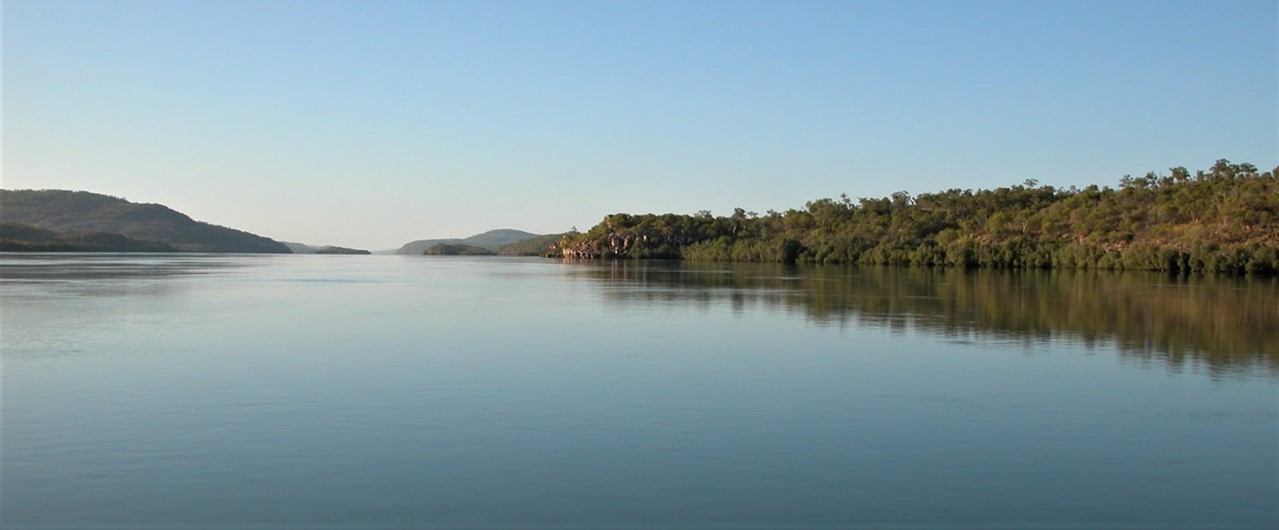Many Kimberley travellers particularly those visiting by sea, are generally fortunate enough to travel inland along estuaries like that of the Berkeley, King George, Hunter, Sale or the Prince Regent rivers. This article presents two contrasting river estuaries, one where the now flooded valley has been controlled by many angled joints as seen along the King George River, the other the Prince Regent River where the estuary follows a single straight joint. The King George River ends in Koolama Bay and the Prince Regent River terminates at Saint George Basin. Features of both the bay and the basin are considered in a separate Background Briefing article.
During their formation the course of the river valley is determined by many factors as run-off rainwater follows the effect of gravity heading downstream toward the sea. Water may run over rock surfaces that vary in their resistance to the flow such as a ‘tough’ quartzite or a ‘soft’ siltstone. The resultant depth of the are rills, gullies or valleys formed in less resistant rock is likely to be deeper than that which is resistant to weathering.
As modern day travellers we are unable to follow these early stages of river valley formation in the Kimberley but two of the Kimberley estuaries, the King George and the Prince Regent rivers provide superb examples where after many, many million years the pattern of the rock jointing has had a major influence on the shape of the resulting valleys and the estuaries they now fill in their tidal section.
A primer – rock joints, weathering and erosion, land uplift and sea levels.
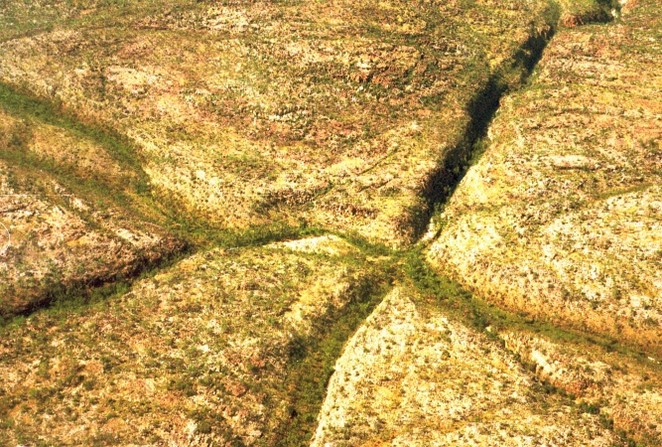
By definition, joints are rock fractures where either side of the fracture has not been substantially displaced laterally (to the left or right) or vertically (upwards or downwards). If displacement were to occur the fracture is referred to as a fault.
Running through most of the Kimberley rock surfaces are deep joints a feature that is not immediately evident to the average observer walking across a landscape. However, when identified by field geologists and mapped from broadscale aerial images taken from aircraft or satellites, we see joints that are quite numerous and follow a pattern. Although the joints may vary in length, they are mostly straight and over the Kimberley are oriented in either SE (southeast) to NW (northwest) or a SW (southwest) to NE (northeast) direction. It is believed that the alignment of the fractures in the rocks initially resulted from tremors emanating from earth moving tectonic forces that were building mountains along the east-south-east and the south-south-western edges of the Kimberley block 1,000 million years ago.
Under the influence of gravity runoff water flows downwards and this may be interrupted when it enters a waterbody such as a lake and ultimately stops at the level of the sea. During the flow water may be channelled into joint fractures and low points where frictional forces of the water tend to wear way the rock particles so making the joint wider and deeper. Any previously weathered rock sediments carried by the water increases friction thus accelerating weathering and forming deep channels. Should any crossing, intersecting joint offer a ‘better’ downhill direction the flow will match the new direction. As a result, water flow may follow joints that take a zig-zag route so determining the channel direction of the resulting creeks and rivers on their way to the sea.
Uplift of the Kimberley has occurred in the past on a couple of occasions many 100s of million years ago. A result of these massive uplifts the rivers too were uplifted and had further to drop to reach sea level. In terms of their land forming processes, rivers have rejuvenated powers of weathering and erosion so uplift is likely to result in the deepening of river channels. Cutting down to the base level by rivers was therefore determined by the sea level. With low sea levels in the past, river channels near the sea were much deeper. When sea levels rose again these valleys were flooded.
Most of the weathering and erosion events to produce today’s landforms were stimulated by an uplift just 20 million years ago.
Globally sea levels are intimately connected with temperature averages across the Earth. During cold conditions the volume of water in oceans and seas shrinks and in extremely cold water ice sheets and glaciers form so the liquid water is tied up as a solid thus reducing the level of the oceans and seas. Over time such glacial/ice age conditions may alternate with warmer interglacial) times when water expands, and glaciers and ice sheets melt. Phases of glacial-interglacial events have occurred multiple times during the relatively recent geological Pleistocene epoch that lasted over two million years
With very few mainland glaciers and being distant from the Antarctic, Australia contributed little to the freezing and thawing of water but by connected to the sea was still influenced.
The last ice age in this sequence was the most intense and is referred to by earth scientists as the Last Glacial Maximum (LGM). During the LGM Oceans around Australia saw water receded by a depth of 120m compared to today’s average high tide mark. Around the country this exposed the continental shelf which, for parts of the Kimberley, meant that the rivers valleys extended over the exposed continental shelf for up to 320km to deposit water in the Timor Sea. By way of contrast the narrow shelf as found along most of the NSW coastline had only few 100m exposed.
Timewise, the LGM occurred about 20,000 ya (years ago) and the interglacial melt began about 17,000 ya. As sea level rose the river valleys were flooded until the temperatures and the melt stabilised around 6,000ya. Existing valleys penetrated inland to varying distances so their lower section became tidally flooded and referred to as estuaries.
It is interesting to contemplate that Aboriginal ancestors lived through the colder conditions of the LGM and experienced the exposed shelf, and then the loss of land as the seas rose.
See ‘Background Briefing -overview of Australia’s Kimberley’ for further details.
King George River estuary the twin falls
King George River enters to Timor Sea after discharging into Koolama Bay in the north-eastern corner of the Kimberley. In the SW corner of the bay this river estuary remained hidden from the sailing explorers including Nicolas Baudin in 1803 and Phillip Parker King 1820.
It was not until 1911 that the upper part of the King George River was discover discovered and named by Europeans with an accurate prediction by the discoverer, C. Price Conigrave, of where the river would terminate i.e. Koolama Bay, then known as Rulhieres Bay.
In the eyes of the Traditional owners the lower reaches of this river formed the border between the country of the Miwa speaking people to the west and Kwini country to the east. Since Native Title Land ownership was finally determined in 2013 the area is under the control of the Balanggarra Land Corporation, for the Balanggarra Traditional owners.

Naming some local features
Koolama Bay was named after the ship Koolama was beached here during World War Two. Prior to this it had unofficially been called Rulhieres Bay after the rocky Cape Rulhieres on the north-eastern mouth of the bay and then Calamity Bay. The Cape had been named in honour the French administrator and diplomat Claude Carloman de Rulhière (1735-1791) by Nicolas Baudin (Captain of Geographe) or Louis de Freycinet (master of La Casuarina) when they sailed past in June 1803.
King George River was named by Charles Price Conigrave in honour of King George V. George V succeeded his father Edward VII in 1910.
Features of the River and Estuary
In contrast to the rest of the Kimberley coast, where tidal ranges are meso- (in the 2 to 4m), macrotidal (4 to 8 m) or even greater, this small section of the coast including Koolama Bay and the estuary is subjected to mostly microtidal conditions with just over two metres difference between the highest and lowest tides.
The low tidal range for this estuary means there is not a massive twice-daily in and outflow of tidal waters and these conditions have allowed the development of islands of sediment along the estuary that are populated by mangroves and shallower water populated with sea grasses. Under the current conditions, with the sand spit build-up near the estuary mouth makes this gap quite narrow and from a distance, difficult to distinguish from a 2.8 km long mangrove lined sandy beach to its east and the cliff on the other side
The rest of the large bay is surrounded by cliffs formed from Warton Sandstone one of the typically ‘tough’ Kimberley sandstones. This same rock lines either side to the 13 km long estuary as it zig-zags inland to terminate in twin waterfalls carrying King George River freshwater off the Karunjie Plateau.
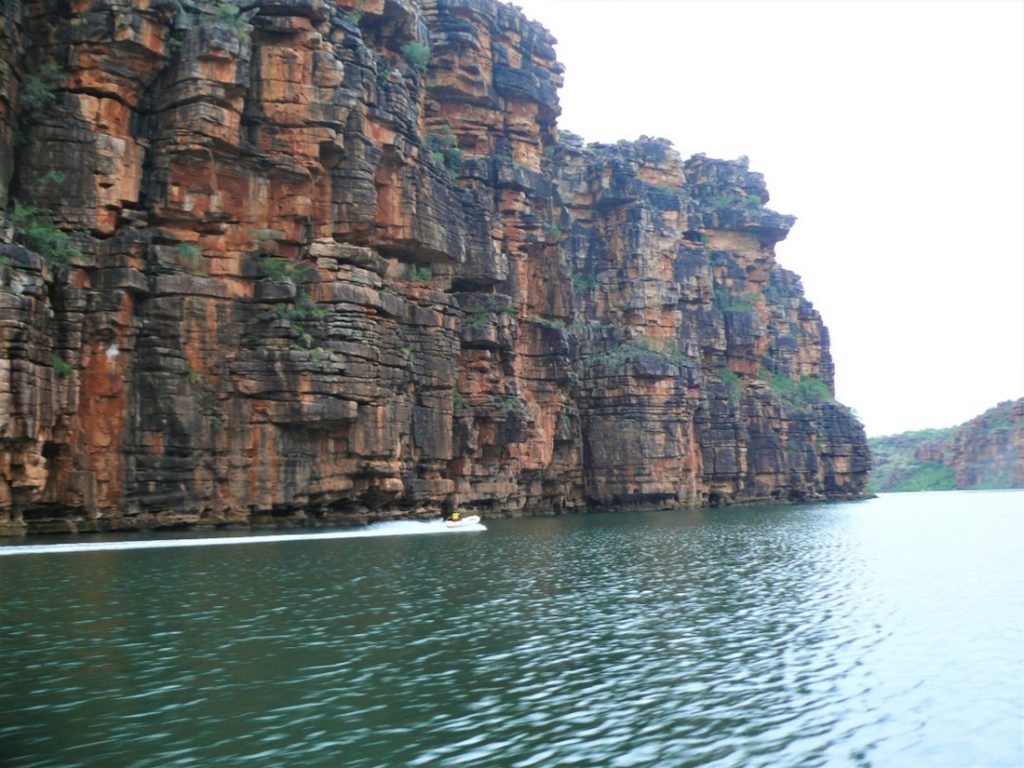
The zig-zag channel of the river has followed the pattern of joints in the sandstone and these are aligned in either a SE to NW or SW to NE direction. Opening-up of the joints to form the river channel took place many millions of years ago as the river slowly weathered the sandstone. This has been supported by much wetter conditions in the past. At this time the current Koolama Bay is likely to have been much further out to sea and the bay itself may have been non-existent or quite a different shape without a perimeter of cliffs.
Although the Warton Sandstones were formed over 1,800 mya (million year ago) specialist earth scientists (geomorphologists) suggest that the land-forming processes on the Kimberley coast have produced most of today’s major landforms in the last 20 mya. During this period one could imagine the King George River initially discharging directly into the sea and that the earliest waterfall developed once the land had been uplifted. It is the processes of weathering (wearing away) and erosion (removal of weathered products), brought about by moving water, that have enabled the formation of a deeper cliff-sided channel and the progress of the waterfall inland which has formed this estuary.
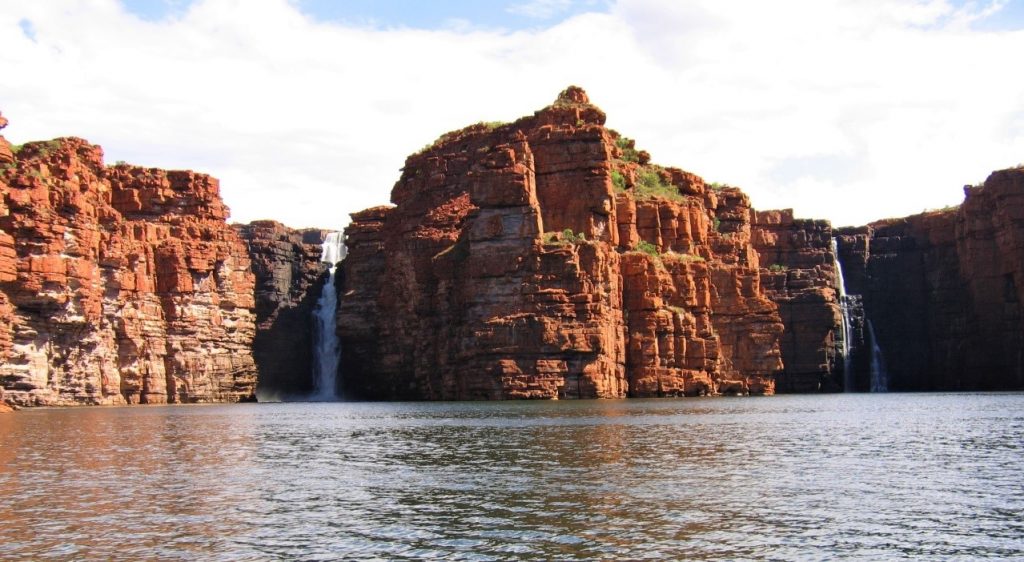
In traditional Lalai stories these majestic falls were created by a male and female rainbow serpents, Wungkurr, who travelled from their distant country to the west, the Sir George Moore Islands. As they travelled inland the river was created.
Today the estuary is over 13 km long and ends in a pair of waterfalls pouring over 8Om cliffs. This long drop particularly during the wet, creates two deep plunge pools beneath falling water. On one occasion echo sounding measurement found the river to be 62 m deep below the eastern most fall. As the river flow decreases following the wet, flow in the west fall creases but that on the east continues though reduced to trickle at the end of the dry. Elsewhere the estuary channel depth varies considerably with most water depths less than 10 m with very moderate tidal effects.
The cliffs both around the Bay and lining the estuary expose the very blocky nature of the weathering Warton Sandstone. The blocks vary greatly in size but tend to have relatively straight margins and in places look as if they were engineered and positioned by modern cranes or past giants! The horizontal lines of the blocks follow the margins of successive layers of sediment from when the sandstone was being deposited. The vertical block surfaces are those of joints created well after the sandstone was rock had consolidated and after earth tremors had passed through the area.
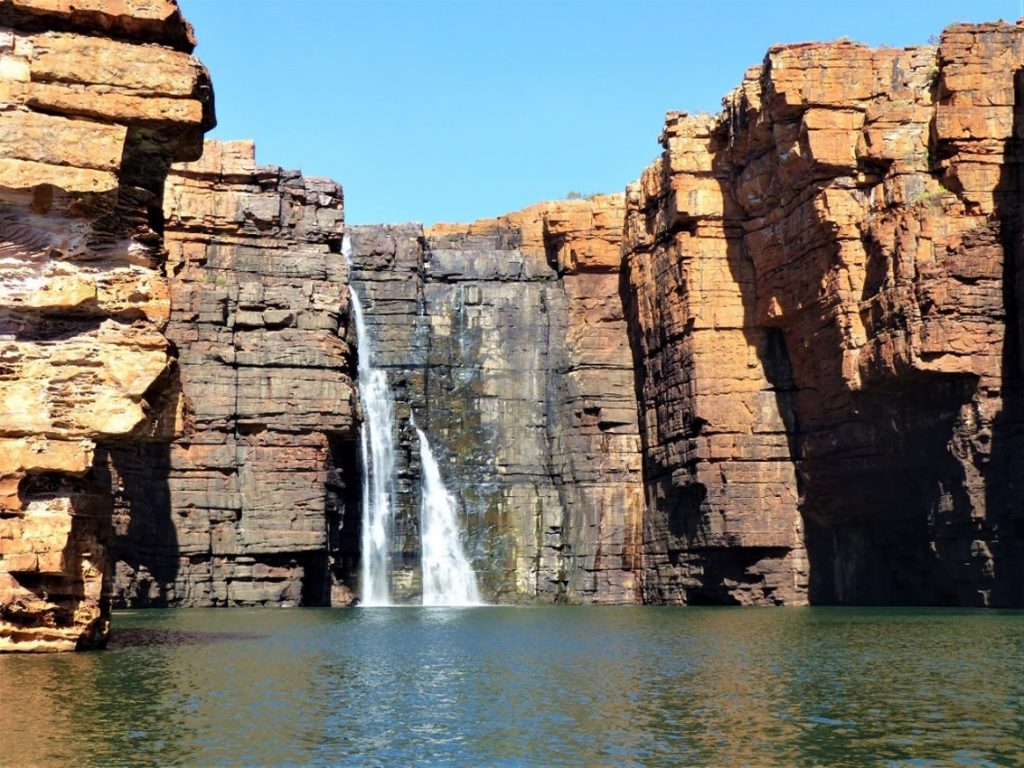
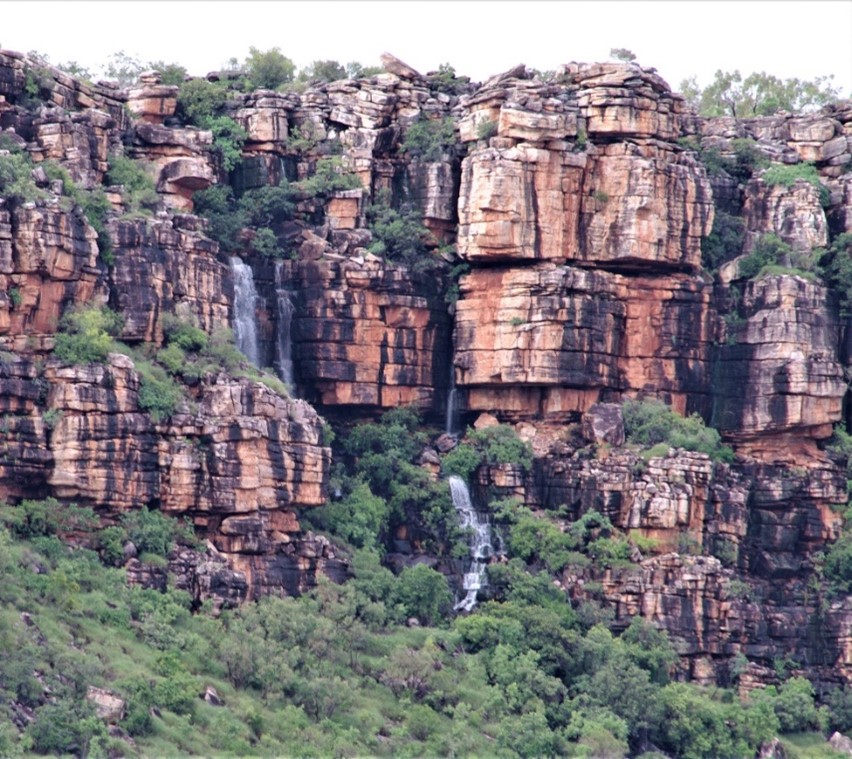
The Prince Regent River and Estuary
The Prince Regent River has been known to Europeans since its discovery by Phillip Parker King in October 1820. He had sailed into St George Basin an inner basin of Brunswick Bay. King continued his explorations by travelling from the Basin in a whale boat up this newly discovered Prince Regent River on an incoming tide. His ship Mermaid remained anchored in the Basin.

This basin and river area is the homeland of the Adbalandi clan who were within the territory covered by the Worroran language and its people. This local country was traditionally referred to as Malandum. Their land was mainly on the southern side of the river with country to the north bordered by people who spoke the Wunambal language. Many of the Lalai (Dreamtime) stories of creation relating to river and that of St George Basin, the river and King Cascade, are told in both languages.
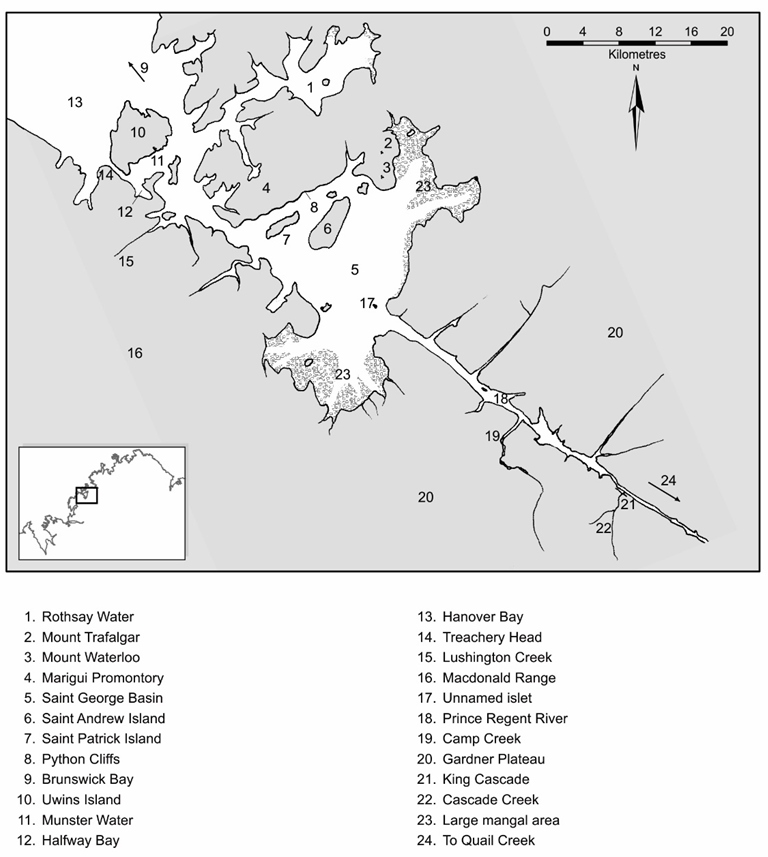
Prince Regent River begins its +100 km course originating near the foot slopes of and Mt Agnes (735 m above sea level). It follow a zig-zag joint path from the mountain slopes and then follows a relatively straight NW-SE joint line. But for one small section on the upper straight where the channel deviates a little then runs for 70 km to St George Basin. For at least half of this distance, the section that was explored by King, the estuary is influenced by the oceanic semidiurnal tidal pattern of two highs and two lows each 24 hours and 50 minutes. Still on the river and returning to the Mermaid, King decided that rather than rowing against the tidal current they were to sleep in a small river island -here he estimated that the tide had risen by 30 feet (between 9 and 10 metres) during the night between the low and high.
An aerial view of the river illustrates the checkerboard nature of the rock joints and shows that where the main channel is joined by a tributary it tends to enter at right angles having cut its channel along a NE-SW joint. One of the larger sized navigable tributaries, referred to a Camp Creek, runs its first 3 km to the SW along a straight channel.
A most historic and interesting feature about 32 km upstream from the Basin is a 200m wide cascade below Cascade Creek and it falls into a large pool that also enters the main channel at right angles. As this creek is spring fed means that it tends to have some flow of fresh water even during the dry season and is not wholly dependant on the wet season flows. The cascade is rock stepped and drops about 45 m to the tidal pool which during very low tides, exposes large expanses of its muddy base.
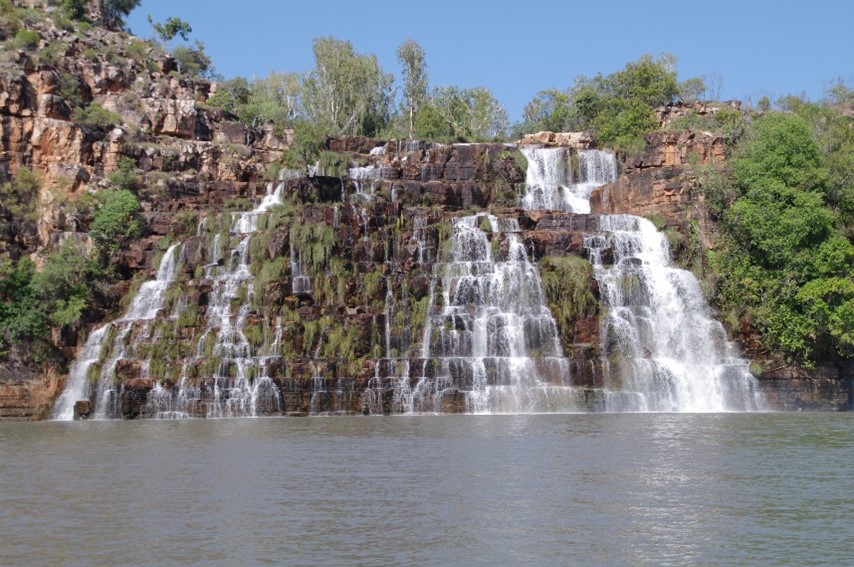
The rock type here and for the majority of the Prince Regent River course is Wunaamin Mulliwundi Sandstone (previously known as King Leopold Sandstone). This is a relatively resistant rock type and most of the river and estuary lies between rocky resistant sandstone cliffs. The valley between the parallel cliffs is about 200 m wide but narrows further upstream. Downstream the valley has been widened in a few locations due to the presence of a less resistant rock. At these points there is evidence of the rock, Hart Dolerite.


About 1,760 mya molten Dolerite lava the was forced between the sandstone strata and cooled to fill joints and form horizontal sheets called sills. Dolerite, unlike the resistant sandstone is easily weathered when exposed to air and water. As the river channel has deepened it cut across a sill embedded in the sandstone. Once exposed it weathers and undermines the sandstone as weathering products are washed away. With no support the sandstone falls and the so gradually widening the channel at this point. The Dolerite is dark in colour and when weathered forms reddish soil. Weathering of large, above ground sills of Dolerite forms rounded hills unlike the sheer rocky landforms of sandstone.
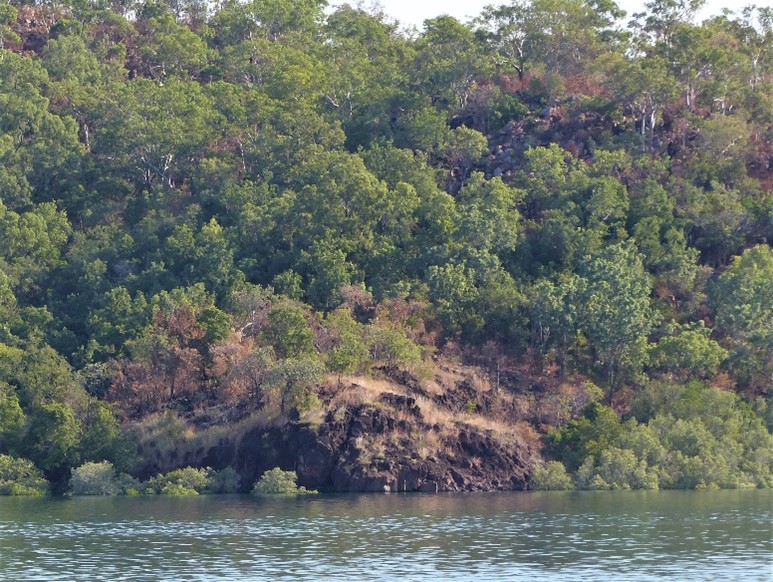
Further reading:
See ‘Background Briefing -features of Koolama Bay and Saint George Basin’ for the changed geology and landforms once the Prince Regent River estuary reaches St George Basin.

